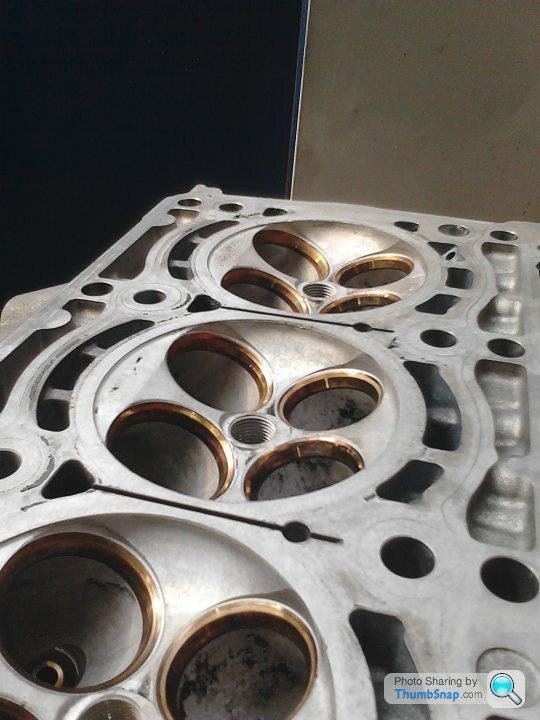BHP of Full race 1700 X-flow
Discussion
poppopbangbang said:
Our most advanced engines calibrated for 102 octane fuel are producing over 700bhp @ 17,000RPM but produce over 300NM of torque from 12,000 RPM to the limiter. Peak torque BMEP is approaching 14 bar which whilst not extreme on it's own is quite good when you consider that's at 14K RPM on an engine with 115mm long con rods and you don't achieve that BMEP at those speeds or VEs in the 115% region without good cylinder filling.
Interesting. 14 bar bmep = 82 ft lbs per litre which at 115% VE is exactly the same 1.4 multiplier ratio I mentioned above as being a good guideline for "normal" octane fuel and CR to estimate VE from torque per litre.I'm a little surprised the specific torque is so low even allowing for the high rpms being used but then as you say it did move on up again considerably a few years later with more development.
Looking at some of your other threads to see who you are and what you do it appears you have an interesting job
 I've always fancied having a poke about inside the cylinder head of even a 10 or 15 year old F1 engine to see how the design rules that engineers with essentially unlimited budgets have arrived at compare to my own humble findings on the flowbench over the years.
I've always fancied having a poke about inside the cylinder head of even a 10 or 15 year old F1 engine to see how the design rules that engineers with essentially unlimited budgets have arrived at compare to my own humble findings on the flowbench over the years.I'd be fascinated to find out more about the valve sizes, port and throat diameters and flow figures if you have any info you can share.
PeterBurgess said:
So it looks as if, if we accept DV is not being economical with the truth, we have moved on from a max achievable lbs/ft per litre at the onset of this thread to 85/86 rather than an inflexible 70/80 ?
I'm getting pretty sick and tired of your constant technique of creating "strawman" arguments, things that someone else has never said, and then arguing against those. The GUIDELINES on my website are not and never have been "inflexible maxima", they are specifically and carefully described as being sensible targets for modified road engines on limited budgets and pump fuel. It goes on to explain how they can be exceeded with state of the art work and how figures up to mid 90s ft lbs per litre and even 100 ft lbs per litre can arise from special cases which are not relevant to the average road or club race customer who might otherwise be at the mercy of unscrupulous engine tuners claiming ridiculous power figures.If you can't debate honestly by actually reading properly what other people have written then by all means go forth and multiply somewhere else. You seem to have a knack of getting people's backs up every time you come in here.
Pumaracing said:
I'm a little surprised the specific torque is so low even allowing for the high rpms being used but then as you say it did move on up again considerably a few years later with more development.
We are down quite a bit on where the engines were in competition as we run less exotic fuels, less advance and less revs and require 2.5 times the life from them that the teams did. I'd say we are about 15% off the figures they made back in the day which whilst a lot to sacrifice is the only way to cost effectively run them these days!Pumaracing said:
Looking at some of your other threads to see who you are and what you do it appears you have an interesting job  I've always fancied having a poke about inside the cylinder head of even a 10 or 15 year old F1 engine to see how the design rules that engineers with essentially unlimited budgets have arrived at compare to my own humble findings on the flowbench over the years.
I've always fancied having a poke about inside the cylinder head of even a 10 or 15 year old F1 engine to see how the design rules that engineers with essentially unlimited budgets have arrived at compare to my own humble findings on the flowbench over the years.
I'd be fascinated to find out more about the valve sizes, port and throat diameters and flow figures if you have any info you can share.
I have a pair of Fondmetal V10 heads you're welcome to measure if you like? They were doing 780bhp in qualifying spec in their last evolution.  I've always fancied having a poke about inside the cylinder head of even a 10 or 15 year old F1 engine to see how the design rules that engineers with essentially unlimited budgets have arrived at compare to my own humble findings on the flowbench over the years.
I've always fancied having a poke about inside the cylinder head of even a 10 or 15 year old F1 engine to see how the design rules that engineers with essentially unlimited budgets have arrived at compare to my own humble findings on the flowbench over the years.I'd be fascinated to find out more about the valve sizes, port and throat diameters and flow figures if you have any info you can share.
Pumaracing said:
I'd be fascinated to find out more about the valve sizes, port and throat diameters and flow figures if you have any info you can share.
Have you seen this...http://www.f1technical.net/forum/viewtopic.php?f=4...
Thanks for that post Stevesingo, interesting read. I note the bronze valve seat inserts, we have been retrofitting these for folks with the very high revving single cylinder four stroke bike engines. We were lead to believe the bronze absorbs shock and prevents damage to the valve seats at the high revs. We find the inlet valves die(mushrooming of seat) before the ex valves purely down to weight difference and effects of 14000rpm +.
We did a lot of work on some 70s DFV heads and manifolds for a customer. The inlet manifolds were not OE to his heads as the oe ones were machined to the heads and to themselves with a forerunner of cnc type milling mahines, we had to match em up again, the original finish looked identical to those in the post you linked
Peter
We did a lot of work on some 70s DFV heads and manifolds for a customer. The inlet manifolds were not OE to his heads as the oe ones were machined to the heads and to themselves with a forerunner of cnc type milling mahines, we had to match em up again, the original finish looked identical to those in the post you linked

Peter
reggid said:
I at to chuckle when one guy in the audience said he was running a 310 degree cam with a 9.75 CR in a NA motor  thanks for the link interesting stuff
thanks for the link interesting stuff  regarding said X Flow personally playing with X Flow's in the late 80's/early 90's I cannot see that motor making that HP at those revs I was making around 160 from the same displacement with offset REC valves flat tops and a biggish cam on bigger chocked 45's at similar RPM
regarding said X Flow personally playing with X Flow's in the late 80's/early 90's I cannot see that motor making that HP at those revs I was making around 160 from the same displacement with offset REC valves flat tops and a biggish cam on bigger chocked 45's at similar RPM  this was with a clockwork reworked Lotus dizzy but that wont affect peak HP
this was with a clockwork reworked Lotus dizzy but that wont affect peak HP 
Edited by Sardonicus on Tuesday 8th April 11:58
stevesingo said:
Wow. That must be the best stuff I've ever seen on the internet. Valves splayed in both planes and cam lobes ground at an angle to the shaft to operate them. Never seen anything like it.However the bit that really blew me away was finding close up shots and measurements of the valve seats and angles. No matter how long you do what I do you always end up agonising about whether you've got anywhere close to optimum and what do the guys who really know and have unlimited budgets end up doing.
We've had discussions on valve seats in here before. This is the main thread.
http://www.pistonheads.com/gassing/topic.asp?h=0&a...
In the first few pages I set out my own rules for seat widths and angles and throat diameters. I've always used seat widths much wider than the 1mm so called "race seats" that you so commonly find in engines, even on valves as big as Chevy V8s. The debate has even raged on for many years with DV who uses 1.5mm on everything from Minis to big block Chevies when I say the seat width should be proportional to the valve size because surely if a particular profile works best then that must scale up and down in proportion to the component sizes.
No matter what the flow bench tells you if you can't conduct the heat away from the valve head through a seat of decent width your thermal efficiency and VE will suffer. For cooking engines I use 4.5% of the valve diameter on the inlet side and the same width seat on the smaller exhaust valve. For really high output engines that get rebuilt more often I'll go down on that a tad but never as far as something like a 1mm seat on a 2 inch valve. Even with the small valves in a 4v head I won't be cutting seats narrower than about 1.25mm to 1.5mm wide depending on the valve size.
I also go into some detail about the long 70 degree bottom cut I use and the distinctive appearance you end up with as I posted below on page 2 of the thread.
"In fact if you bore the inlet throat to about 86% of the inlet valve diameter, cut a seat that's 4.5% of the inlet valve diameter wide you'll end up with a 70 degree bottom cut about 2.5 times as long as the valve seat. So for example with a 45mm diameter inlet valve this will end up as a seat 2mm wide and a bottom cut 5mm long. It's a very distinctive appearance to the seat that's unlike what you'll see in most heads with narrow seats and short bottom cuts that are only about as long as the seat itself."
So I'm astonished to see the pics and measurements in the thread you reference of seats in an F1 head that look almost exactly like I've described using in my own engines. Ok so they use a 40 degree seat not a 45 to get a slightly better compromise between good sealing and the good low lift flow of 30 degree seats. Also a small 55 degree break before the long 70 degree bottom cut but other than small details the seat widths, angles and overall profile is near as dammit exactly what I was talking about 2 years ago.
I am quite taken aback to be honest. I never thought I'd get to find out what people at that level of competition actually do and couldn't even have dreamed that's it's about the same as I've arrived at over the years on zero budget and a poxy little home made flowbench.
PeterBurgess said:
Thanks for that post Stevesingo, interesting read. I note the bronze valve seat inserts, we have been retrofitting these for folks with the very high revving single cylinder four stroke bike engines. We were lead to believe the bronze absorbs shock and prevents damage to the valve seats at the high revs. We find the inlet valves die(mushrooming of seat) before the ex valves purely down to weight difference and effects of 14000rpm +.
We did a lot of work on some 70s DFV heads and manifolds for a customer. The inlet manifolds were not OE to his heads as the oe ones were machined to the heads and to themselves with a forerunner of cnc type milling mahines, we had to match em up again, the original finish looked identical to those in the post you linked
Peter
They're Copper Beryllium. We did a lot of work on some 70s DFV heads and manifolds for a customer. The inlet manifolds were not OE to his heads as the oe ones were machined to the heads and to themselves with a forerunner of cnc type milling mahines, we had to match em up again, the original finish looked identical to those in the post you linked

Peter
Pumaracing said:
I've had some interesting feedback from DV. In the nearly 40 years since he wrote his Pinto book he's up from the 82 ft lbs per litre he maxed out at back then to about 85 now. Very good for a 2v 4 pot IMO but obviously a mile away from what any of us can achieve from almost any 4v 4 pot just by doing a decently ported head, buying off the shelf cams and slapping it all together. Quite where the 4v advantage specifically resides is another matter which we need to discuss further but it can only really be in the head and valvetrain as everything else can be made very similar.
American V8s are totally non comparable. Every original part of the Chevy or Ford engines from the 50s has been redesigned to remove every stock restriction. Custom cast heads, CNC machined, with ports big enough to supply any valve size. Discharge coefficients on the inlet side 15% to 20% higher than anything we could achieve from an average stock 2v 4 pot head before hitting a waterway. Millions of man hours spent on flowbenches and dynos optimising port and chamber shapes, valve trains, exhaust and inlet manifolds.
The only way to get a Crossflow even close to what he's achieved on the Pinto would mean changing so much it wouldn't be a Crossflow any more. Redesign the head and pistons from scratch for starters to make the ports more downdraft and much bigger, put a proper combustion chamber in there and use normal pistons to get a decent burn. Eliminate all the flex in the valve train with bigger cam bearings and lobes, move it higher in the block to shorten the pushrods, redesign the rockers and increase their ratio. A few million quid should cover it though.
Anyway, I think this particular horse has been flogged enough.
I agree completely with thisAmerican V8s are totally non comparable. Every original part of the Chevy or Ford engines from the 50s has been redesigned to remove every stock restriction. Custom cast heads, CNC machined, with ports big enough to supply any valve size. Discharge coefficients on the inlet side 15% to 20% higher than anything we could achieve from an average stock 2v 4 pot head before hitting a waterway. Millions of man hours spent on flowbenches and dynos optimising port and chamber shapes, valve trains, exhaust and inlet manifolds.
The only way to get a Crossflow even close to what he's achieved on the Pinto would mean changing so much it wouldn't be a Crossflow any more. Redesign the head and pistons from scratch for starters to make the ports more downdraft and much bigger, put a proper combustion chamber in there and use normal pistons to get a decent burn. Eliminate all the flex in the valve train with bigger cam bearings and lobes, move it higher in the block to shorten the pushrods, redesign the rockers and increase their ratio. A few million quid should cover it though.
Anyway, I think this particular horse has been flogged enough.
In reality to get the claimed power figures from a 1700cc xflow engine the following would be needed:
- Custom cast head with fully downdraft inlet ports
- Maximum valve sizes, much larger inlet to exhaust ratio
- Heavily modified pushrod valvetrain with larger followers, hollow pushrods, followers moved up away from cam to create more room for high lobe lift with a larger base circle, possibly needle roller cam bearings
- Or full OHC conversion and at least 14mm valve lift
- Combustion chambers in head ideally and flat top pistons
- Everything else maximum tuned to get the best performance out of the head
- Biggest key is breathing ability, xflow heads and valvetrain are very airflow restrictive vs other engines, a genuine 198bhp at 6950rpm from 1700cc is no small task!
You would basically end up with an OHC fully downdraft chambered head
Here is a picture of an 1800cc ARE xflow with a claimed 199.7bhp and 150.1lb/ft from just 11 months ago
https://www.facebook.com/media/set/?set=a.66721013...
From what I can see of this engine it does Not have a full on downdraft head, the port angle is much more like 90*!
It is an alloy cnc head, ATP throttle bodies, dry sump etc
If this is anything like the claimed engine with 1700cc and 198bhp at 6950rpm then I call BS!
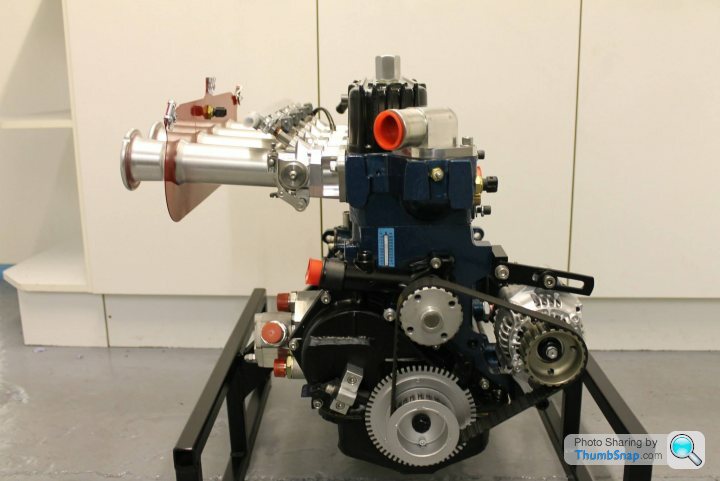
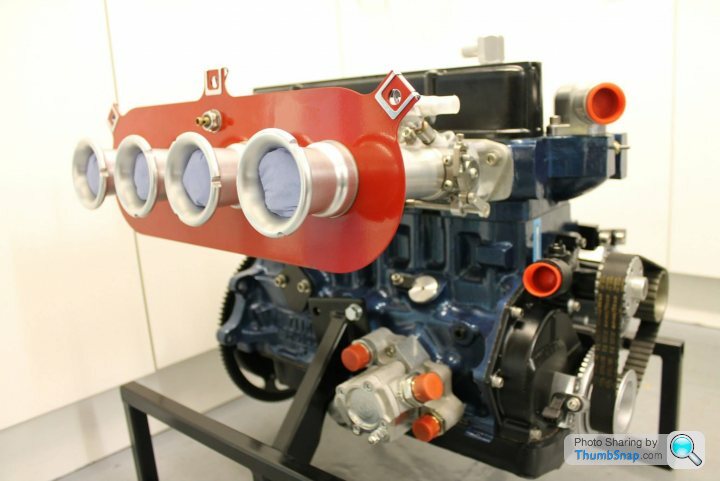
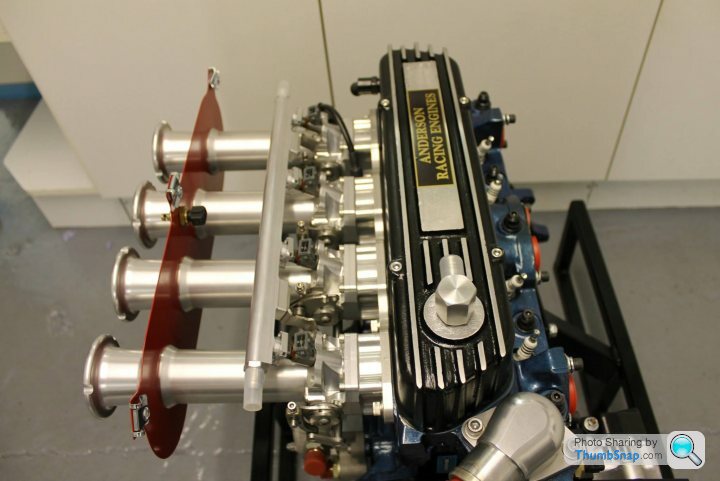
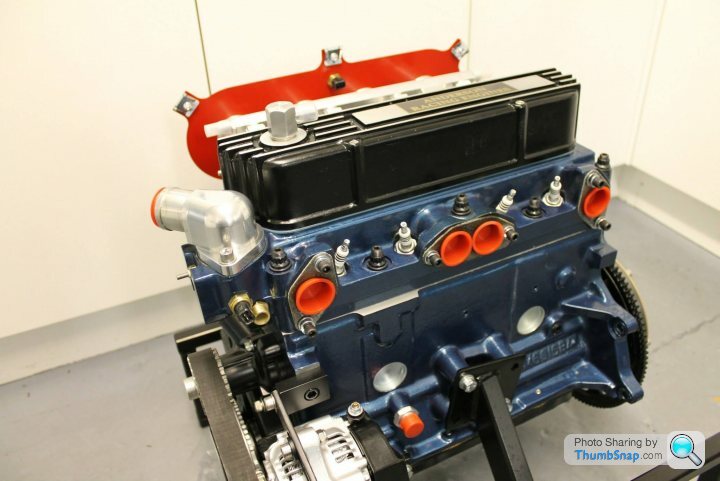
stevesingo said:
Evoluzione said:
They're Copper Beryllium.
Are you sure? Beryllium was banned in if F1 in 2001. The article states that this engine was one of the last V10s, which would post date 2001.I recognise the colour as we use them occasionally.
They look pretty much copper coloured to me.
The heads could have been made before that date.
It says they are in the the Q & A session afterwards.
Rwdfords said:
Here is a picture of an 1800cc ARE xflow with a claimed 199.7bhp and 150.1lb/ft from just 11 months ago
At least that's all in the realms of believability with 83 ft lbs per litre flywheel dry sumped. We can estimate torque at peak power rpm as being approx 93% of peak torque so 140 ft lbs. That gives peak power rpm as 200/140 x 5252 = 7500 which is much more reasonable.200 bhp from 1700cc at less than 7k and over 160 ft lbs is clearly nonsense though. Someone somewhere is very confused.
poppopbangbang said:
We are down quite a bit on where the engines were in competition as we run less exotic fuels, less advance and less revs and require 2.5 times the life from them that the teams did. I'd say we are about 15% off the figures they made back in the day which whilst a lot to sacrifice is the only way to cost effectively run them these days!
Ah gotcha. That makes sense. So nearly as much torque per litre in their original incarnation as the Crossflow that started this thread eh 
Sorry, couldn't resist

poppopbangbang said:
I have a pair of Fondmetal V10 heads you're welcome to measure if you like? They were doing 780bhp in qualifying spec in their last evolution.
That's an extraordinarily generous offer and if I wasn't 600 miles away I'd love to take you up on it. The data in the thread Stevesingo has pointed us to has answered many of my questions though and given me much to think about. Fiendishly clever these inscrutable F1 engine designers eh what?Much lively debate later........So to get up to date, no one seems to be happy with 90+lbsft litre, so instead of trying to prove my dyno faulty which gives folk great amusement, what if the dynos are somewhere close? That would mean the engine would have to be a lot bigger wouldn't it? So if we take 86lbs ft as a hard to reach (but not impossible) target, the engine would have to be around 1900 cc, not unheard of in racing circles making engines a little larger than the rules suggest?
Gentlemen, if I had built the engine I would say what size it was and what CR and what fuel, but I didnt, I am only the messenger
Dave, be honest, if this thread hadn't been posted none of us would have seen that most excellent link to the post on F1 stuff would we?
Peter
Gentlemen, if I had built the engine I would say what size it was and what CR and what fuel, but I didnt, I am only the messenger

Dave, be honest, if this thread hadn't been posted none of us would have seen that most excellent link to the post on F1 stuff would we?
Peter
Just to add fuel to the fire
Last years Cosworth F1 V8 makes 98 ftlb/ ltr
http://www.f1technical.net/forum/viewtopic.php?f=4...
Last years Cosworth F1 V8 makes 98 ftlb/ ltr
http://www.f1technical.net/forum/viewtopic.php?f=4...
"oss remanufacture the TR4 Cast Iron head, it has been improved as there has been input from a few head modifiers and is a better base casting than the original. I started work on TR4 engines in 1986, first championship 1987,88,89 etc etc We pushed the engine bhp up by 35 to 162 at the wheels over those three years. It helped development as folk beat a path to use our rolling road and head modding abilities. We continue to improve the TR4 engine, with some £100000 invested by a TR4 race driver (not that we have seen anything like...just lots of dyno time and about 10 heads developed. With independant engine dyno work and rolling road work we are all agreeing on 177 at the wheels and just over 200 at the engine. Engine dyno suggests lbsft/litre is 87 on the best we have all done together ( five businesses working on this as a project...engine dyno not Agra or Anderson). What I am trying to say is the power creeps forwards under development. We have pushed, with limited monetary input, the TR4 Race Engine from 162 in 1989 to 177 at the wheels in 2014, not lots but steady progress. Imagine what the TR4 engine would produce if it was the Nascar engine of choice, I am willing to bet it would make our efforts look crap"
Peter,
You guys are still leaving a lot on the table. Spend about $10k on developing the valvetrain and figuring out how to make it live with lift numbers higher than you're running, and work on the cylinder head program to make sure the port is stable on the bench at those lift values and beyond.
Remember, we're dealing an engine with less bore than stroke and zero included valve angle - so the intake valve is the smoking gun in terms of making power. If you can't add valve area - just keep lifting it further. This will have the effect of having more opening area for a given crank degree rotation (ie: higher lift means more lift at *70 crank rotation, etc.).
With our race gas, the top few engine builders in the United States are working at numbers approaching to and exceeding 100hp/L for the BMC A and B series, and the Triumph engines.
For example, the best SCCA FP 1275cc A-Series engines:
.040" overbore max
Stock valve sizes
Stock rod lengths
No adding material
HS4 Carburetors allowed
Dry sump allowed
HP 102-103% VE at around 7600rpm and Torque: 106% VE at 5900rpm
Peter,
You guys are still leaving a lot on the table. Spend about $10k on developing the valvetrain and figuring out how to make it live with lift numbers higher than you're running, and work on the cylinder head program to make sure the port is stable on the bench at those lift values and beyond.
Remember, we're dealing an engine with less bore than stroke and zero included valve angle - so the intake valve is the smoking gun in terms of making power. If you can't add valve area - just keep lifting it further. This will have the effect of having more opening area for a given crank degree rotation (ie: higher lift means more lift at *70 crank rotation, etc.).
With our race gas, the top few engine builders in the United States are working at numbers approaching to and exceeding 100hp/L for the BMC A and B series, and the Triumph engines.
For example, the best SCCA FP 1275cc A-Series engines:
.040" overbore max
Stock valve sizes
Stock rod lengths
No adding material
HS4 Carburetors allowed
Dry sump allowed
HP 102-103% VE at around 7600rpm and Torque: 106% VE at 5900rpm
Edited by hoffman900 on Sunday 21st February 18:02
Gassing Station | Engines & Drivetrain | Top of Page | What's New | My Stuff





